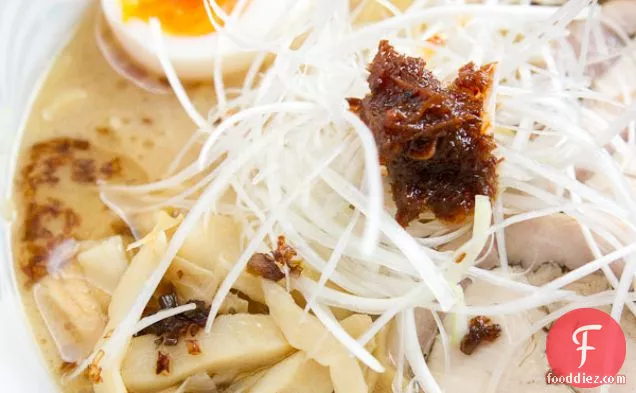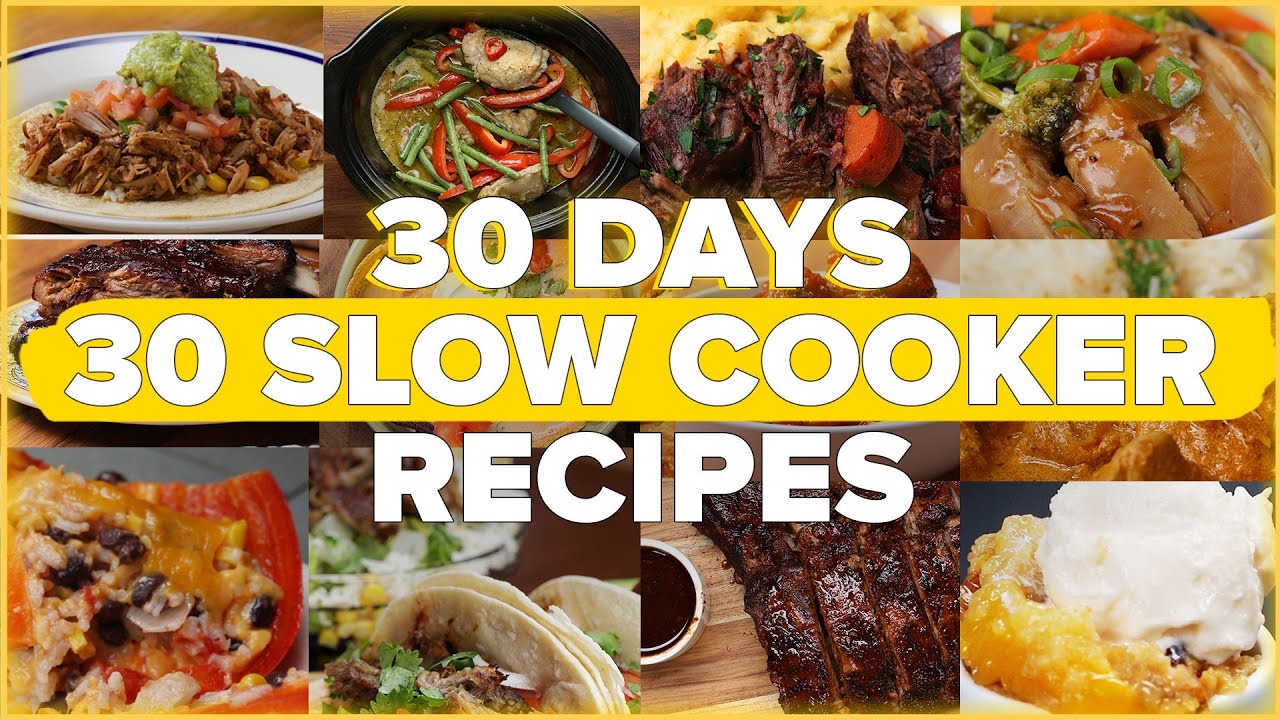Chicken Ramen

Chicken Ramen might be just the main course you are searching for. This recipe covers 20% of your daily requirements of vitamins and minerals. This recipe makes 4 servings with 614 calories, 28g of protein, and 15g of fat each. This recipe is typical of Japanese cuisine. Head to the store and pick up vegetable oil the aromatics, chicken bones, servingsramen noodles according to package directions, and a few other things to make it today. To use up the water you could follow this main course with the Watermelon-Peach Slushies as a dessert. From preparation to the plate, this recipe takes approximately 1 hour and 4 minutes.
Instructions
2
Lay the wing tips and chicken bones in a clean sink, then pour the boiling water over the chicken. Wash the chicken with cold water, scrubbing off any clumps of blood. This step solidifies some of the blood on the chicken so you can wash it off and it doesn't end up in your soup. In a small saucepan, add the leeks, ginger and garlic, then cover with vegetable oil. Gently fry over medium low heat until the aromatics are dark brown, but not burnt (about 30-40 minutes).
Ingredients you will need![Chicken Bones]() Chicken Bones
Chicken Bones![Vegetable Oil]() Vegetable Oil
Vegetable Oil![Whole Chicken]() Whole Chicken
Whole Chicken![Garlic]() Garlic
Garlic![Ginger]() Ginger
Ginger![Leek]() Leek
Leek![Water]() Water
Water![Soup]() Soup
Soup
Equipment you will use![Sauce Pan]() Sauce Pan
Sauce Pan
3
Add the kombu, wingtips and bones to a pressure cooker and cover with 10 cups of water. Bring it to a boil uncovered, then skim off the scum that floats to the top. Continue skimming until you don't see any more scum.
Ingredients you will need![Kombu]() Kombu
Kombu![Water]() Water
Water
Equipment you will use![Pressure Cooker]() Pressure Cooker
Pressure Cooker
4
Remove the kombu and discard, then add the fried leeks, ginger and garlic. Seal the lid, then cook under high pressure for 1.5 hours.When the stock is done cooking, let it cool to room temperature.
Ingredients you will need![Garlic]() Garlic
Garlic![Ginger]() Ginger
Ginger![Kombu]() Kombu
Kombu![Leek]() Leek
Leek![Stock]() Stock
Stock
5
Pour it through a large strainer into a large bowl. Squeeze the solids with your hands to extract as much liquid as possible. You'll notice that the liquid starts turning a creamy white. This is what gives the soup its body so be sure you get every last drop.
Ingredients you will need![Soup]() Soup
Soup
Equipment you will use![Sieve]() Sieve
Sieve![Bowl]() Bowl
Bowl
6
Pour the strained soup through an extra fine sieve (such as a tea strainer) into a clean container. You can either stop here and refrigerate the stock or keep going.If you refrigerated the stock, it should be fairly easy to scrape off the excess fat with a spoon. If not, use a fat skimmer to skim off the extra fat and set the fat aside. In either case, you want to leave a little fat behind. Measure your the soup. You should have about 6 cups, if you have more, you should boil it down to 6 cups, if you have less, add water.To make the caramelized scallion oil, add the sesame oil along with about 2 tablespoons of chicken fat that you've skimmed from the soup to a small saucepan.
Ingredients you will need![Chicken Fat]() Chicken Fat
Chicken Fat![Sesame Oil]() Sesame Oil
Sesame Oil![Green Onions]() Green Onions
Green Onions![Stock]() Stock
Stock![Water]() Water
Water![Soup]() Soup
Soup![Cooking Oil]() Cooking Oil
Cooking Oil![Tea]() Tea
Tea
Equipment you will use![Sauce Pan]() Sauce Pan
Sauce Pan![Sieve]() Sieve
Sieve![Skimmer]() Skimmer
Skimmer
7
Put the saucepan over medium heat, then add the minced scallions. Fry the scallions until they are medium to dark brown in color. Turn off the heat, then carefully add 1 tablespoon of soy sauce. The oil will sputter, so be very careful. This caramelizes the soy sauce, giving it a wonderful toasty aroma. To make the soup, add the 6 cups of strained stock to a pot, add 1 tablespoon of soy sauce, 1 tablespoon of salt, and the soy milk and gently heat.Boil your noodles according to the package directions or make a batch of homemade ramen noodles.To finish the ramen divide the noodles between four bowls, pour the soup over the noodles then top with your choice of toppings. I served this with a soft boiled egg, menma, shredded scallions, and chicken chashu, but what you top it with is up to you. Boil your noodles according to the package directions.
Ingredients you will need![Ramen Noodles]() Ramen Noodles
Ramen Noodles![Green Onions]() Green Onions
Green Onions![Soy Sauce]() Soy Sauce
Soy Sauce![Soymilk]() Soymilk
Soymilk![Whole Chicken]() Whole Chicken
Whole Chicken![Pasta]() Pasta
Pasta![Stock]() Stock
Stock![Salt]() Salt
Salt![Soup]() Soup
Soup![Egg]() Egg
Egg![Cooking Oil]() Cooking Oil
Cooking Oil
Equipment you will use![Sauce Pan]() Sauce Pan
Sauce Pan![Bowl]() Bowl
Bowl![Pot]() Pot
Pot
Ingredients
59milliliters![esame oil]() esame oil907grams
esame oil907grams![chicken bones]() chicken bones454grams
chicken bones454grams![chicken wing tips]() chicken wing tips4large cloves
chicken wing tips4large cloves![garlic unpeeled]() garlic unpeeled1Tbsp
garlic unpeeled1Tbsp![oy sauce]() oy sauce237milliliters
oy sauce237milliliters![oy milk]() oy milk1package
oy milk1package![4servingsramen noodles boiled according to directions]() 4servingsramen noodles boiled according to directions4servings
4servingsramen noodles boiled according to directions4servings![3scallions white part only, minced]() 3scallions white part only, minced4servings
3scallions white part only, minced4servings![vegetable oil for frying the aromatics]() vegetable oil for frying the aromatics2liters
vegetable oil for frying the aromatics2liters![water]() water1Tbsp
water1Tbsp![alt]() alt
alt
 esame oil907grams
esame oil907grams chicken bones454grams
chicken bones454grams chicken wing tips4large cloves
chicken wing tips4large cloves garlic unpeeled1Tbsp
garlic unpeeled1Tbsp oy sauce237milliliters
oy sauce237milliliters oy milk1package
oy milk1package 4servingsramen noodles boiled according to directions4servings
4servingsramen noodles boiled according to directions4servings 3scallions white part only, minced4servings
3scallions white part only, minced4servings vegetable oil for frying the aromatics2liters
vegetable oil for frying the aromatics2liters water1Tbsp
water1Tbsp alt
altRecommended wine: Chenin Blanc, Gewurztraminer, Riesling
Chenin Blanc, Gewurztraminer, and Riesling are great choices for Asian. The best wine for Asian food depends on the cuisine and dish - of course - but these acidic whites pair with a number of traditional meals, spicy or not. You could try Lang & Reed Napa Valley Chenin Blanc. Reviewers quite like it with a 4.5 out of 5 star rating and a price of about 30 dollars per bottle.

Lang & Reed Napa Valley Chenin Blanc
The Lang & Reed 2015 Chenin Blanc – Napa Valley has peach and tropical fruit that are immediately on the nose, with the necessary hint of honeycomb (the traditional varietal character), and a lesser expression of apple and citrus. On the palate, the aromas are mirrored and given an even stronger presence with yellow apple exotic citrus notes, which give it an accurate tartness. The texture is tender, and the flavors broaden with a touch of saline minerality, which leads into bright crisp acidity, adding to the wine’s refreshing character. It will blossom and gain in complexity with additional bottle time.DifficultyExpert
Ready In1 h, 4 m.
Servings4
Health Score17
Related recipes
Turkey with Country Ham Stuffing
Party Italian Wedding Soup
Turkey Alfredo Tetrazzini
Stuffed Shells with Meat Sauce
Magazine

Your Inner Chef with Taylor Swift's Top 3 Recipes from Her Beloved NYC Hangout

20 Mouthwatering Recipes You Need to Try Today!

Master the Art of Making Perfect Pancakes with This Foolproof Recipe

The Science Behind Red Wine: Its Surprising Health Benefits and Potential Risks

12 Wine Cocktails for a Sophisticated Twist

Sip, Swirl, and Celebrate: Toasting to National Wine Day on May 25th

National Drink Wine Day on February 18

Celebrating Souffle Day with Delectable Delights

Indulge in the Delightful Flavor of Oyster Soup on Its Special Day!

Celebrating World Nutella Day

Celebrating Costa Rica Independence Day with an Authentic Culinary Experience

Grab the Best Deals on Food Gifts: Black Friday and Cyber Monday Specials

The Black Food Festival: A Culinary Adventure Like No Other

The Rich and Flavorful Black Food Traditions in Netflix's 'High on the Hog'

10 Slow Cooker Recipes to Keep You Warm and Cozy in January

10 Delicious and Refreshing Cocktail Recipes for January!

Stay Cozy and Warm with These Delicious Winter Recipes

Rainbow Food by Colors for a Nutrient-Rich and Vibrant Diet

The Future of Nutritionthe New and Improved Food Pyramid

Food Pyramids from Different Cultures

Your Inner Chef with Taylor Swift's Top 3 Recipes from Her Beloved NYC Hangout

20 Mouthwatering Recipes You Need to Try Today!

Sip, Swirl, and Celebrate: Toasting to National Wine Day on May 25th

National Drink Wine Day on February 18

Indulge in the Delightful Flavor of Oyster Soup on Its Special Day!

These Super Recipes for Your Football Party!

The Secrets Behind 3 Classic Comfort Food Recipes

Recipes to Spice Up Your February Menu

Top 20+ Must-Try Recipes Dominating February 2024






